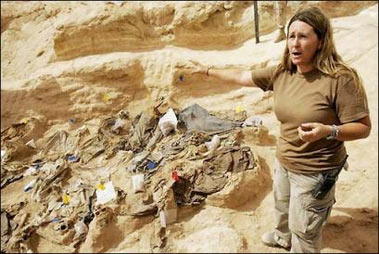
An
Australian forensic expert speaks near a mass grave. The Iraqi High
Tribunal is exhuming bodies from mass graves as it prepares trials against
members of the toppled Saddam Hussein regime over the suppression of a
1991 Shiite uprising. [AFP] |
He said the killings were carried out in desert areas where the victims could
be thrown into shallow embankments or simply shot there.
The bodies of 28 men, estimated to be 20 to 35 years old, have been found so
far in one of the graves, with small blue, yellow and red flags marking the
findings - including spent cartridges and bullets. One wrist still bore a
watch.
The victims were wearing clothing favored by Shiites, including dishdashas,
and most were blindfolded. The blindfolds appear to have been fashioned from
keffiyehs, traditional Arab headdresses, said Kerry Grant, a 45-year-old
Australian forensic archaeologist at the site.
One skeleton was wearing a blue jacket and his hands were behind his back,
suggesting they had been tied. A plastic flip flop, a tennis shoe and some
skulls with hair on them also could be seen at the site.
"Going by the clothing, I think they were grabbed very quickly," Grant said.
The leaders of the team of about 120 people said they were motivated to keep
working, despite searing heat, by their desire for justice for the victims.
"When you work with the remains for a long time, you get very attached to
them and you feel very badly for them," Trimble said, adding the remains would
be repatriated when they were no longer needed as evidence.
Kerry also expressed regret that the team was unlikely to find all the bodies
dumped in the area of about three miles.
"We know there is more in the area, but there is only so much we can do. We
can't be here too long," she said.
The second site - in a ravine about 72 feet deep and 33 feet wide -
had only been under excavation since late last week.